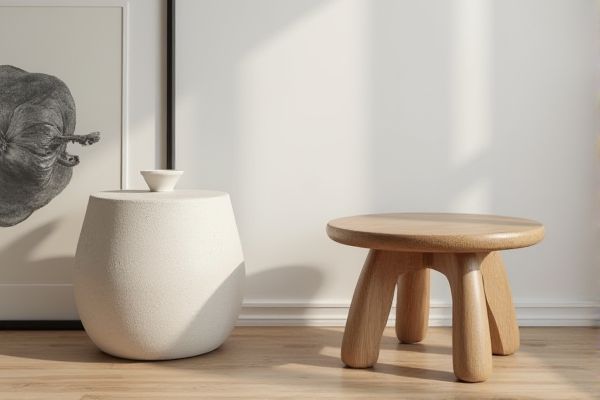
Ceramic stools offer durability and a sleek, modern aesthetic that withstands moisture and stains better than wooden stools, which provide warmth, natural texture, and versatility with various finishes for different interior styles. Explore the rest of the article to discover which stool best complements your space and lifestyle.
Table of Comparison
| Feature | Ceramic Stool | Wooden Stool |
|---|---|---|
| Material | High-quality ceramic | Solid wood, e.g., oak, pine |
| Durability | Strong but prone to cracking | Highly durable and repairable |
| Weight | Heavier and less portable | Lighter and easy to move |
| Maintenance | Requires gentle cleaning to avoid chips | Needs occasional polishing and protection |
| Design | Glossy, decorative, modern | Classic, rustic, customizable |
| Comfort | Hard surface | More comfortable with natural texture |
| Cost | Generally higher price | Varies, often more affordable |
| Environmental Impact | Non-biodegradable, energy-intensive production | Renewable and biodegradable |
Introduction to Ceramic and Wooden Stools
Ceramic stools offer a sleek, modern aesthetic with durable, easy-to-clean surfaces that resist moisture and stains, making them ideal for both indoor and outdoor use. Wooden stools provide a warm, natural look with sturdy construction and the ability to be refinished or customized, enhancing the character of any room. Your choice depends on whether you prioritize the lightweight versatility of ceramic or the timeless, organic appeal of wood.
Material Properties: Ceramic vs Wooden Stools
Ceramic stools offer a smooth, non-porous surface that is resistant to moisture and stains, making them ideal for outdoor or humid environments. Wooden stools provide natural warmth and durability, with varying hardness depending on the wood type, but may require regular maintenance to prevent damage from moisture and wear. Your choice depends on whether you prioritize the sleek, easy-to-clean nature of ceramic or the traditional, sturdy feel of wood.
Durability and Longevity Comparison
Ceramic stools offer exceptional durability due to their resistance to moisture, stains, and scratches, making them ideal for both indoor and outdoor use. Wooden stools, while sturdy, are more susceptible to wear over time, including potential cracking, warping, and damage from exposure to humidity or pests. Proper treatment and maintenance can extend the lifespan of wooden stools, but ceramic remains the superior choice for long-term longevity and minimal upkeep.
Design and Aesthetic Appeal
Ceramic stools offer sleek, glossy finishes and intricate patterns that enhance modern and artistic spaces, while wooden stools provide warm, natural textures with versatile styles ranging from rustic to contemporary. Ceramic materials allow for vibrant colors and unique shapes, making them standout decor pieces, whereas wooden stools bring timeless charm and organic appeal through grains and finishes. Both options provide distinct design aesthetics suited for different interior themes, with ceramics emphasizing bold visual statements and wood delivering cozy, traditional elegance.
Comfort and Ergonomics
Ceramic stools offer a sleek surface but may lack cushioning, making them less comfortable for prolonged sitting compared to wooden stools, which often provide a warmer feel and slight natural flex for better ergonomics. Wooden stools can be ergonomically shaped to support your posture, reducing strain during extended use. Choosing the right material affects how comfortably you can sit and maintain proper alignment.
Maintenance and Cleaning
Ceramic stools require minimal maintenance, as their non-porous surface resists stains and can be easily cleaned with a damp cloth and mild detergent. Wooden stools demand regular care, including polishing to protect the finish and prevent moisture damage or warping over time. Your choice between ceramic and wooden stools should consider the ease of upkeep based on your lifestyle and space usage.
Suitability for Indoor and Outdoor Use
Ceramic stools are highly suitable for outdoor use due to their resistance to weather conditions and moisture, making them ideal for patios and gardens. Wooden stools, while offering warmth and natural aesthetics indoors, are prone to damage from water and uv exposure, requiring treatment or limited outdoor placement. For indoor settings, wooden stools provide comfort and variety in design, whereas ceramic stools offer durability and easy maintenance in both environments.
Environmental Impact and Sustainability
Ceramic stools are made from natural clay and fired at high temperatures, resulting in a durable product that can be recycled or repurposed without releasing harmful chemicals. Wooden stools, especially those sourced from sustainably managed forests, offer renewable and biodegradable options but may contribute to deforestation if sourced irresponsibly. Both materials' environmental footprints depend heavily on manufacturing processes and sourcing practices, with ceramic production demanding significant energy input and wood offering carbon sequestration benefits during growth.
Cost and Value Considerations
Ceramic stools often come with a higher upfront cost due to the materials and craftsmanship involved, but they offer long-term value through durability and low maintenance. Wooden stools generally have a lower initial price and provide a warm, natural aesthetic but may require more upkeep and can be prone to wear over time. When choosing between the two, consider your budget alongside the intended use and longevity needs to determine which option delivers the best value for your space.
Choosing the Right Stool: Key Takeaways
Ceramic stools offer a sleek, durable surface ideal for both indoor and outdoor use, resisting moisture and stains more effectively than wooden stools. Wooden stools provide natural warmth and can be easily customized or refinished to match your decor, but they may require more maintenance to prevent damage from water or wear. When choosing the right stool, consider your environment, style preferences, and how much upkeep you're willing to manage to ensure your stool remains functional and visually appealing.
 homyna.com
homyna.com